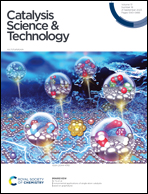g-C3N4 coupled with 2,4,6-tris(4-aminophenyl)-1,3,5-triazine via π–π interactions enhanced visible-light photocatalytic H2 evolution from water splitting†
Abstract
Graphitic carbon nitride (g-C3N4) is an attractive candidate among the most promising metal-free photocatalysts under visible light for solar-to-fuel production. Nevertheless, the low photocatalytic performance and fast recombination rate of photoinduced charge carriers prevent its practical applications. Therefore, the integration of g-C3N4 with an appropriate material is highly desirable for enhancing H2 production. In this work, we report a TAPT/CN composite photocatalyst formed from g-C3N4 and 2,4,6-tris(4-aminophenyl)-1,3,5-triazine (TAPT) through π–π interactions and hydrogen bonds to enhance the photocatalytic activity. The small TAPT molecules act as a hole relay and thus elevate the transfer rate of holes from g-C3N4 to triethanolamine (TEOA); this in turn favors more electron transfer to the Pt cocatalyst and finally promotes the visible-light-driven H2 generation. The experimental results display that photocatalytic activity is greatly boosted by TAPT molecules in TAPT/CN nanoheterostructures. The optimized 5% TAPT/CN (5 wt% TAPT loading) sample achieves a maximum H2 evolution rate of 99.54 μmol h−1, which is 7.1 times higher than that of bare g-C3N4 (14.01 μmol h−1). Additionally, there is no significant decrease in H2 production after five consecutive cycles of continuous visible-light irradiation of up to 20 hours. We expect that this research will open the door to designing other organic material-decorated g-C3N4 photocatalysts for potential applications in solar-to-hydrogen energy conversion.



 Please wait while we load your content...
Please wait while we load your content...